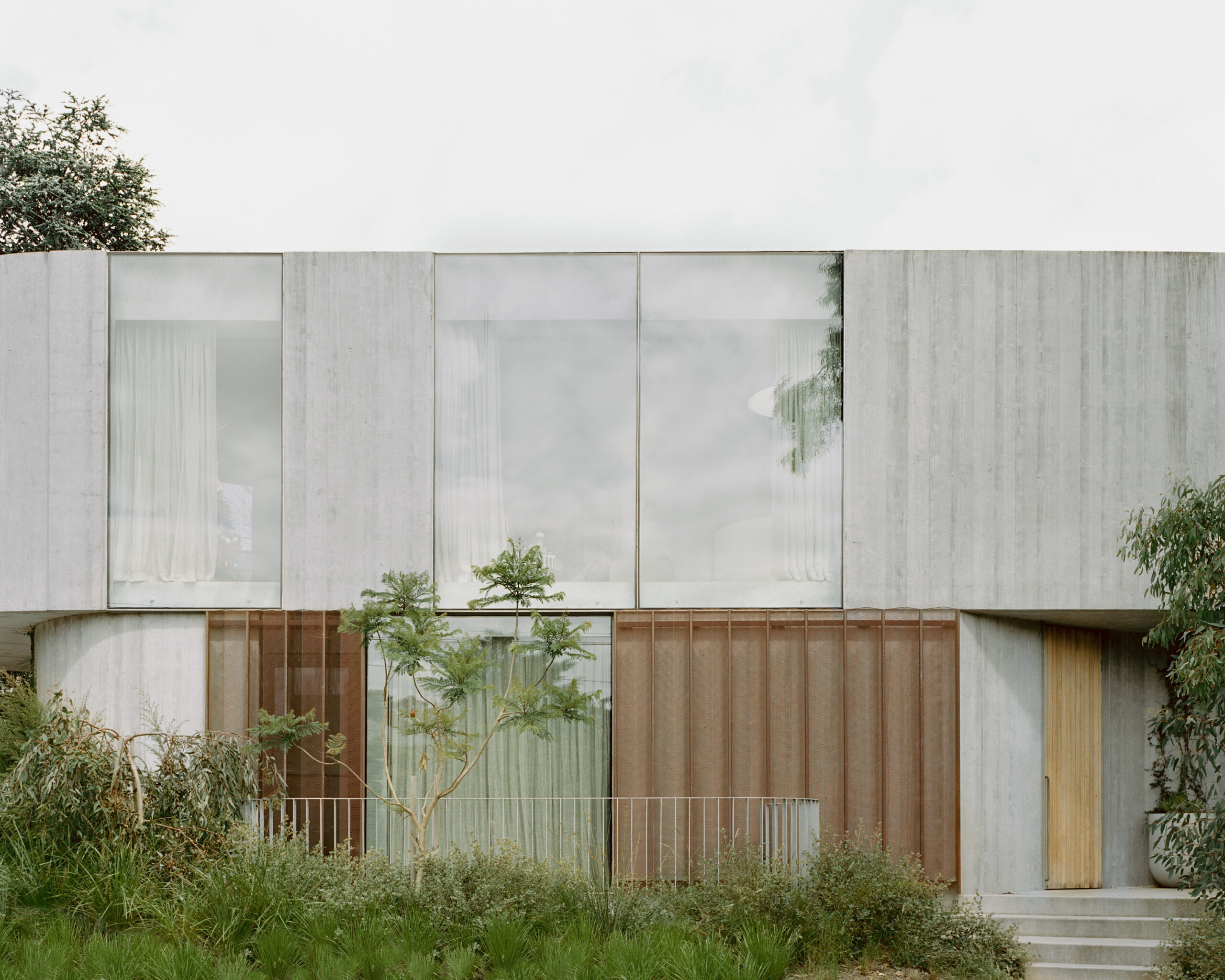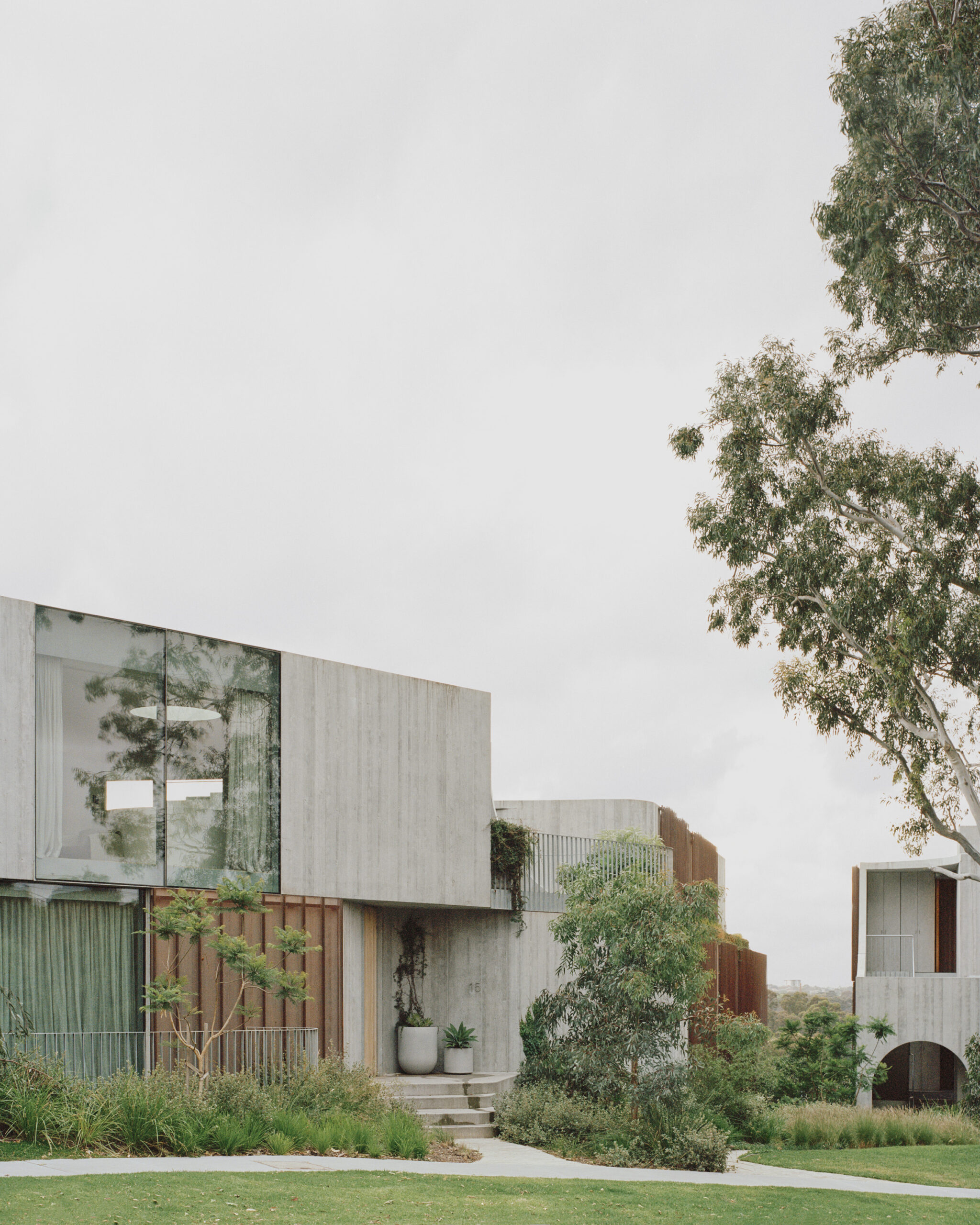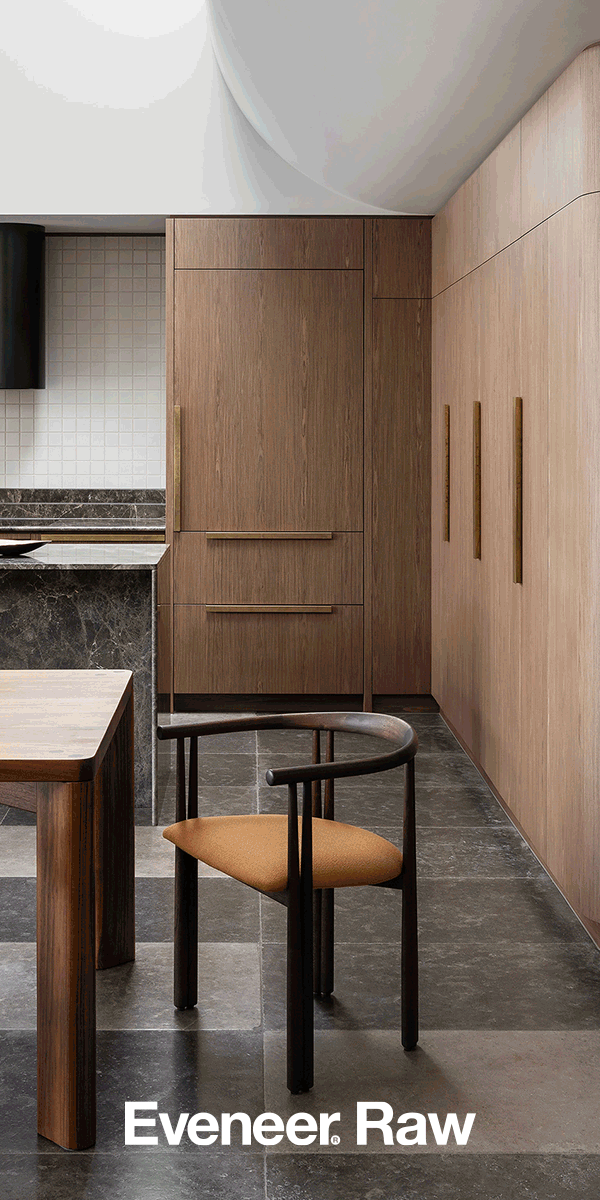After nearly two decades of design, problem solving and innovation, NaughtOne has unveiled its compelling rebrand, strengthening its core beliefs,...
Fenwick: Edition Office
With its panoramic views of the Birrarung, Yarra Bend Park and the Melbourne cityscape, Kew’s Fenwick residence complex burgeons from the escarpment as an artful extension of the surrounding landscape – a testament to the necessary intersection between built environments and Country, a convergence that Edition Office founders and Fenwick co‑designers Kim Bridgland and Aaron Roberts claim can no longer be ignored.
Essay
Sophie Swift
Photography
Rory Gardiner

Clarity is intrinsic to Edition Office. Founded by Kim Bridgland and Aaron Roberts in Melbourne in 2016, their practice is internationally renowned for their commitment to context. Their Fenwick multi-residential project, located in the Melbourne suburb of Kew, on Wurundjeri Woi-wurrung Country, was completed in 2022 by an ANGLE-commissioned project team that included Flack Studio and Eckersley Garden Architecture.
The site of Fenwick is particularly spectacular. It sits high above the Birrarung (Yarra River), on a steep, exposed, north-facing escarpment with views over Yarra Bend Park and the valleys beyond. Its lower banks wind through the city of Naarm/Melbourne, flowing 242km from Yalukit-willam (Hobson Bay) and through to the Yarra Ranges.
Such an intense mediation of place and landscape must be considered with an awareness of Country. The name Birrarung, meaning ‘River of Mist’, was bestowed by the Wurundjeri people of the Kulin nation. Enduring colonialism, the name has been a vital cultural and ecological life source for millennia. For residential projects, Bridgland and Roberts reflect on a Country-first approach that foregrounds respect. “It’s not appropriate for this building to tell the story of that place. It just isn’t. But we hope it is appropriate for this project to give grace to that site … [to give] a context and an awareness to it … then it just lets it be. [It doesn’t] speak for it,” they share.
Curious about their attentiveness to the natural world in their projects, I asked Bridgland and Roberts about their childhood and what it was like to grow up in semi-rural, bushy and slightly wild regions. Describing the moments of slow observation that came with growing up in Blackheath, on Darug Country, Kim shares, “The house I grew up in was on the escarpment edge facing the Kanimbla Valley … looking west forever. As a kid, I’d sit at the window, watching storms rolling in, eight hours before they even got to our house, watching these grand weather patterns happening in this kind of amphitheatre of the valleys below. There was this big awareness of the wonderful drama of weather – cloud formations would build up in the valley like a flowing bathtub, then slowly lift up into a fog.”

Both Bridgland and Roberts see architecture as a conduit for connecting to place. Their projects provide vantage points for inhabitants to witness broad phenomenological forces and focus on the immediate changes on the site. Considering the Australian landscape, they create architecture that “withstands the intensities of weather, howling winds and bushfires that sear through”. They are invested in “an architectural approach that interfaces with the kind of cadence of time passing, weather shifting and the reality of now”. Fenwick is used as a reference point, redirecting and emphasising relationships to Birrarung, as well as the layers of relational context at closer scales. The site straddles two vastly different conditions: the steep fall of escarpment to the north and the domestic scales and patterns of a suburban street to the south. Eager to move away from the typical signifiers associated with an apartment building, the nine dwellings exist within three separate pavilions rather than a singular uniform structure. This broken form connects to context in two ways: the three independent figures allow deep vistas through the site while presenting to the street as two-storey in preservation of domestic proportions.
This negative space is enhanced with the building’s materiality. South-facing glazing sits flush against rounded pre-cast concrete and sheaths of delicate copper-mesh screening. This acute definition
of what is landscape and what is building foregrounds the latter, a trait that Edition Office consistently return to in their work.
The gardens in their projects often encompass the immediacy of site. Designed by Eckersley, the gardens feature wild explosions of native plants that climb across the building. The most intense of this flourishing occurs at the fulcrum of the site – a green centre between the north and south. With rationalised linear floorplans, this fulcrum serves as a meeting point between the three pavilions, giving over to curvilinear expression. There is a tension point in this void space, expressed with scalloping, delicate cutaways and joyful detailing that emphasises human scale.

This point in the facades, where the edges of the pavilions start to peel away, fraying and eroding towards the escarpment edge, marks a point of departure. The north-facing facade passively retreats – deep awnings ensure the escarpment isn’t loaded with a glass box facing the view. Glass and the interiors of the apartments instead become recessive, providing the escarpment and its bush a visual dominance.
Living spaces located on this northern edge celebrate the “thrill and drama of watching weather on high ground”. Bridgland and Roberts describe the phenomena that passes over and below the exposed escarpment: the migration path of bats drifting through clouds above, the arc of the sun to the north over the city.
Material is often considered superfluous to the function of a facade. In Fenwick, the use of copper mesh screens establishes Bridgland and Roberts’ departure from traditional apartment detailing and their focus on fixtures. Resisting the blunt encounters that often occur with mandated privacy instruments, the copper mesh screens create layered views. The copper is part of a material palette that revels in entropy as it patinas over time. Playing with qualities of light and perspective, the pleated veils frame the dynamic window views of the overflowing green corridors. Residents can re-engage with the natural surroundings: the river winding through the terrain, the escarpment rising above it and, during the evenings, the interplay of mist and light in the clouds.
edition-office.com

The rectilinear building mass does not attempt to mimic organic forms. Rather, it asserts itself as a building and allows the surrounding landscape to become the focus.

Privacy between apartments is achieved through copper mesh on the facade that will weather over time.

A cut-through in the building provides site lines through the site. By fracturing the structure it becomes more possible to set Fenwick ‘within’ the site instead of ‘upon’ the site.

The verdant garden includes a mix of native and imported species. The crisp, pale-grey formwork of Fenwick retreats into the landscape, allowing the planting to occupy into the foreground.

